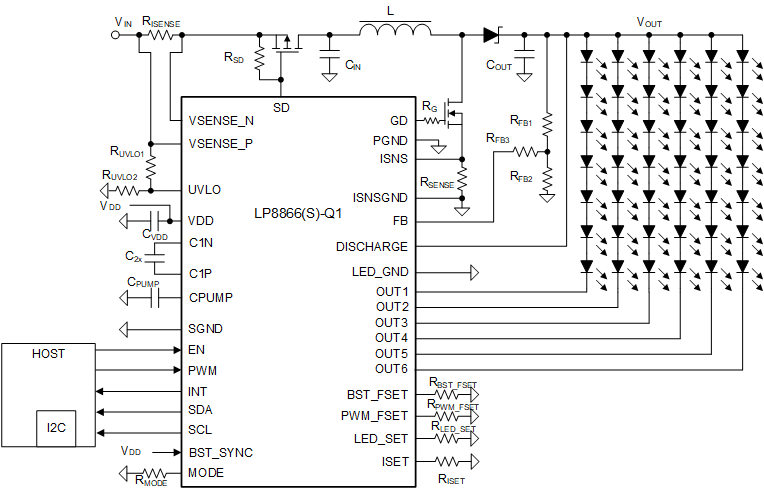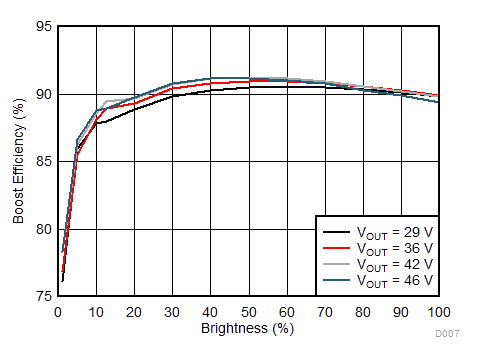ZHCSLM9B August 2020 – May 2024 LP8866S-Q1
PRODUCTION DATA
- 1
- 1 特性
- 2 应用
- 3 说明
- 4 Pin Configuration and Functions
- 5 Specifications
-
6 Detailed Description
- 6.1 Overview
- 6.2 Functional Block Diagram
- 6.3
Feature Description
- 6.3.1 Control Interface
- 6.3.2 Function Setting
- 6.3.3 Device Supply (VDD)
- 6.3.4 Enable (EN)
- 6.3.5 Charge Pump
- 6.3.6 Boost Controller
- 6.3.7 LED Current Sinks
- 6.3.8 Brightness Control
- 6.3.9
Protection and Fault Detections
- 6.3.9.1 Supply Faults
- 6.3.9.2
Boost Faults
- 6.3.9.2.1 Boost Overvoltage Faults (BSTOVPL, BSTOVPH)
- 6.3.9.2.2 Boost Overcurrent Faults (BSTOCP)
- 6.3.9.2.3 LEDSET Resistor Missing Faults (LEDSET)
- 6.3.9.2.4 MODE Resistor Missing Faults (MODESEL)
- 6.3.9.2.5 FSET Resistor Missing Faults (FSET)
- 6.3.9.2.6 ISET Resistor Out of Range Faults (ISET)
- 6.3.9.2.7 Thermal Shutdown Faults (TSD)
- 6.3.9.3 LED Faults
- 6.3.9.4 Overview of the Fault and Protection Schemes
- 6.4 Device Functional Modes
- 6.5 Programming
-
7 Application and Implementation
- 7.1 Application Information
- 7.2
Typical Applications
- 7.2.1
Full Feature Application for Display Backlight
- 7.2.1.1 Design Requirements
- 7.2.1.2
Detailed Design Procedure
- 7.2.1.2.1 Inductor Selection
- 7.2.1.2.2 Output Capacitor Selection
- 7.2.1.2.3 Input Capacitor Selection
- 7.2.1.2.4 Charge Pump Output Capacitor
- 7.2.1.2.5 Charge Pump Flying Capacitor
- 7.2.1.2.6 Output Diode
- 7.2.1.2.7 Switching FET
- 7.2.1.2.8 Boost Sense Resistor
- 7.2.1.2.9 Power-Line FET
- 7.2.1.2.10 Input Current Sense Resistor
- 7.2.1.2.11 Feedback Resistor Divider
- 7.2.1.2.12 Critical Components for Design
- 7.2.1.3 Application Curves
- 7.2.2 Application with Basic/Minimal Operation
- 7.2.3
SEPIC Mode Application
- 7.2.3.1 Design Requirements
- 7.2.3.2
Detailed Design Procedure
- 7.2.3.2.1 Inductor Selection
- 7.2.3.2.2 Coupling Capacitor Selection
- 7.2.3.2.3 Output Capacitor Selection
- 7.2.3.2.4 Input Capacitor Selection
- 7.2.3.2.5 Charge Pump Output Capacitor
- 7.2.3.2.6 Charge Pump Flying Capacitor
- 7.2.3.2.7 Switching FET
- 7.2.3.2.8 Output Diode
- 7.2.3.2.9 Switching Sense Resistor
- 7.2.3.2.10 Power-Line FET
- 7.2.3.2.11 Input Current Sense Resistor
- 7.2.3.2.12 Feedback Resistor Divider
- 7.2.3.2.13 Critical Components for Design
- 7.2.3.3 Application Curves
- 7.2.1
Full Feature Application for Display Backlight
- 7.3 Power Supply Recommendations
- 7.4 Layout
- 8 Device and Documentation Support
- 9 Revision History
- 10Mechanical, Packaging, and Orderable Information
封装选项
机械数据 (封装 | 引脚)
散热焊盘机械数据 (封装 | 引脚)
订购信息
3 说明
LP8866S-Q1 是一款具有升压控制器的汽车级高效 LED 驱动器。六个高精度电流阱支持根据使用的通道数自动调整相移。可通过 I²C 接口或 PWM 输入对 LED 亮度进行全局控制。
升压控制器基于 LED 电流阱余量电压进行自适应输出电压控制。该特性可在所有条件下将升压电压调节到能够满足需要的最低水平,从而更大限度降低功耗。凭借宽范围可调频率,LP8866S-Q1 可避免 AM 无线电频段的干扰。
LP8866S-Q1 支持内置混合 PWM 调光和模拟电流调光,可降低 EMI、延长 LED 使用寿命并提高总光学效率。
器件信息
| 器件型号(1) | 封装 | 本体尺寸(标称值) |
|---|---|---|
| LP8866S-Q1 | HTSSOP (38) | 9.70mm × 4.40mm |
| QFN (32) | 5mm × 5mm |
(1) 如需了解所有可用封装,请参阅数据表末尾的可订购米6体育平台手机版_好二三四附录。
 简化版原理图
简化版原理图 系统效率
系统效率